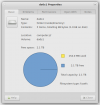I like to do this:
Code:
dmesg | grep da # this shows whether you need to use da0 or da1 in the mount command
gpart show da0 # or da1, depending on output from dmesg
ntfs-3g /dev/da0s1 /mnt/usb # instead of mount -t
TBH, the FreeBSD Handbook covers this, so I'd recommend reading it.
dmseg shown after I plug it in:
da0 at umass-sim0 bus 0 scbus7 target 0 lun 0
da0: <vendor c product code 2.00> Removable Direct Access SPC-2 SCSI device
da0: Serial Number 1945551005782725618
da0: 40.000MB/s transfers
da0: 2000000MB (4096000000 512 byte sectors)
da0: quirks=0x2<NO_6_BYTE>
gpart show:
[root@randy ~]# gpart show
=> 40 976773088 ada0 GPT (466G)
40 1024 1 freebsd-boot (512K)
1064 984 - free - (492K)
2048 4194304 2 freebsd-swap (2.0G)
4196352 972576768 3 freebsd-zfs (464G)
976773120 8 - free - (4.0K)
=> 40 976773088 ada1 GPT (466G)
40 1024 1 freebsd-boot (512K)
1064 984 - free - (492K)
2048 4194304 2 freebsd-swap (2.0G)
4196352 972576768 3 freebsd-zfs (464G)
976773120 8 - free - (4.0K)
=> 63 4095999937 da0 MBR (1.9T)
63 1 - free - (512B)
64 4095999936 1 ntfs [active] (1.9T)
Message after entering: ntfs-3g /dev/da0 /mnt/randy (randy it the directory I made within mnt)
[root@randy ~]# ntfs-3g /dev/da0 /mnt/randy
NTFS signature is missing.
Failed to mount '/dev/da0': Invalid argument
The device '/dev/da0' doesn't seem to have a valid NTFS.
Maybe the wrong device is used? Or the whole disk instead of a
partition (e.g. /dev/sda, not /dev/sda1)? Or the other way around?
partition (e.g. /dev/sda, not /dev/sda1)? Or the other way around?
Message after entering:
root@randy ~]# mount -t ntfs-3g /dev/da0p1 /mnt/randy
mount: /dev/da0p1: Operation not supported by device
and
[root@randy ~]# mount -t ntfs-3g /dev/da0 /mnt/randy
mount: /dev/da0: Operation not supported by device
Since the new Flash Drive is a 2TB device will Windows actually be able to format it with a fat32 file?

